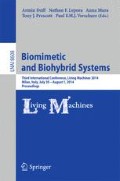Abstract
Researches in psychology and neuroscience have identified multiple decision systems in mammals, enabling control of behavior to shift with training and familiarity of the environment from a goal-directed system to a habitual system. The former relies on the explicit estimation of future consequences of actions through planning towards a particular goal, which makes decision time longer but produces rapid adaptation to changes in the environment. The latter learns to associate values to particular stimulus-response associations, leading to quick reactive decision- making but slow relearning in response to environmental changes. Computational neuroscience models have formalized this as a coordination of model-based and model-free reinforcement learning. From this inspiration we hypothesize that it could enable robots to learn habits, detect when these habits are appropriate and thus avoid long and costly computations of the planning system. We illustrate this in a simple repetitive cube-pushing task on a conveyor belt, where a speed-accuracy trade-off is required. We show that the two systems have complementary advantages in these tasks, which can be combined for performance improvement.
Access this chapter
Tax calculation will be finalised at checkout
Purchases are for personal use only
Preview
Unable to display preview. Download preview PDF.
References
Balleine, B.W., Dickinson, A.: Goal-directed instrumental action: contingency and incentive learning and their cortical substrates. Neuropharmacology 37, 407–419 (1998)
Balleine, B.W., O’Doherty, J.P.: Human and rodent homologies in action control: corticostriatal determinants of goal-directed and habitual action. Neuropsychopharmacology 35, 48–69 (2010)
Caluwaerts, K., Favre-Félix, A., Staffa, M., N’Guyen, S., Grand, C., Girard, B., Khamassi, M.: Neuro-inspired navigation strategies shifting for robots: Integration of a multiple landmark taxon strategy. In: Prescott, T.J., Lepora, N.F., Mura, A., Verschure, P.F.M.J. (eds.) Living Machines 2012. LNCS, vol. 7375, pp. 62–73. Springer, Heidelberg (2012)
Caluwaerts, K., Staffa, M., N’Guyen, S., Grand, C., Dollé, L., Favre-Félix, A., Girard, B., Khamassi, M.: A biologically inspired meta-control navigation system for the psikharpax rat robot. Bioinspiration and Biomimetics (2012)
Daw, N.D., Niv, Y., Dayan, P.: Uncertainty-based competition between prefrontal and dorsolateral striatal systems for behavioral control. Nature Neuroscience 8(12), 1704–1711 (2005)
Dezfouli, A., Balleine, B.W.: Habits, action sequences and reinforcement learning. European Journal of Neuroscience 35(7), 1036–1051 (2012)
Dickinson, A.: Contemporary animal learning theory. Cambridge University Press, Cambridge (1980)
Dickinson, A.: Actions and habits: The development of behavioural autonomy. Phil Trans Roy Soc B: Biol Sci 308, 67–78 (1985)
Dollé, L., Sheynikhovich, D., Girard, B., Chavarriaga, R., Guillot, A.: Path planning versus cue responding: a bioinspired model of switching between navigation strategies. Biological Cybernetics 103(4), 299–317 (2010)
Gat, E.: On three-layer architectures. In: Artificial Intelligence and Mobile Robots. MIT Press (1998)
Huys, Q.J., Eshel, N., O’Nions, E., Sheridan, L., Dayan, P., Roiser, J.P.: Bonsai trees in your head: how the pavlovian system sculpts goal-directed choices by pruning decision trees. PLoS Computational Biology 8(3) (2012)
Kaelbling, L.P., Littman, M.L., Moore, A.W.: Reinforcement learning: a survey. Journal of Artificial Intelligence Research 4, 237–285 (1996)
Keramati, M., Dezfouli, A., Piray, P.: Speed/accuracy trade-off between the habitual and goal-directed processes. PLoS Computational Biology 7(5), 1–25 (2011)
Khamassi, M., Humphries, M.D.: Integrating cortico-limbic-basal ganglia architectures for learning model-based and model-free navigation strategies. Frontiers in Behavioral Neuroscience 6, 79 (2012)
Kober, J., Bagnell, D., Peters, J.: Reinforcement learning in robotics: A survey. International Journal of Robotics Research (11), 1238–1274 (2013)
Lesaint, F., Sigaud, O., Flagel, S.B., Robinson, T.E., Khamassi, M.: Modelling Individual Differences in the Form of Pavlovian Conditioned Approach Responses: A Dual Learning Systems Approach with Factored Representations. PLoS Comput Biol 10(2) (February 2014)
Minguez, J., Lamiraux, F., Laumond, J.P.: Motion planning and obstacle avoidance. In: Siciliano, B., Khatib, O. (eds.) Handbook of Robotics, pp. 827–852. Springer, Heidelberg (2008)
Quigley, M., Conley, K., Gerkey, B.P., Faust, J., Foote, T., Leibs, J., Wheeler, R., Ng, A.Y.: Ros: an open-source robot operating system. In: ICRA Workshop on Open Source Software (2009)
Sutton, R.S., Barto, A.G.: Introduction to Reinforcement Learning, 1st edn. MIT Press, Cambridge (1998)
Watkins, C.: Learning from Delayed Rewards. PhD thesis, King’s College, Cambridge, UK (1989)
Yin, H.H., Ostlund, S.B., Balleine, B.W.: Reward-guided learning beyond dopamine in the nucleus accumbens: the integrative functions of cortico-basal ganglia networks. Eur. J. Neurosci. 28, 1437–1448 (2008)
Author information
Authors and Affiliations
Editor information
Editors and Affiliations
Rights and permissions
Copyright information
© 2014 Springer International Publishing Switzerland
About this paper
Cite this paper
Renaudo, E., Girard, B., Chatila, R., Khamassi, M. (2014). Design of a Control Architecture for Habit Learning in Robots. In: Duff, A., Lepora, N.F., Mura, A., Prescott, T.J., Verschure, P.F.M.J. (eds) Biomimetic and Biohybrid Systems. Living Machines 2014. Lecture Notes in Computer Science(), vol 8608. Springer, Cham. https://doi.org/10.1007/978-3-319-09435-9_22
Download citation
DOI: https://doi.org/10.1007/978-3-319-09435-9_22
Publisher Name: Springer, Cham
Print ISBN: 978-3-319-09434-2
Online ISBN: 978-3-319-09435-9
eBook Packages: Computer ScienceComputer Science (R0)

